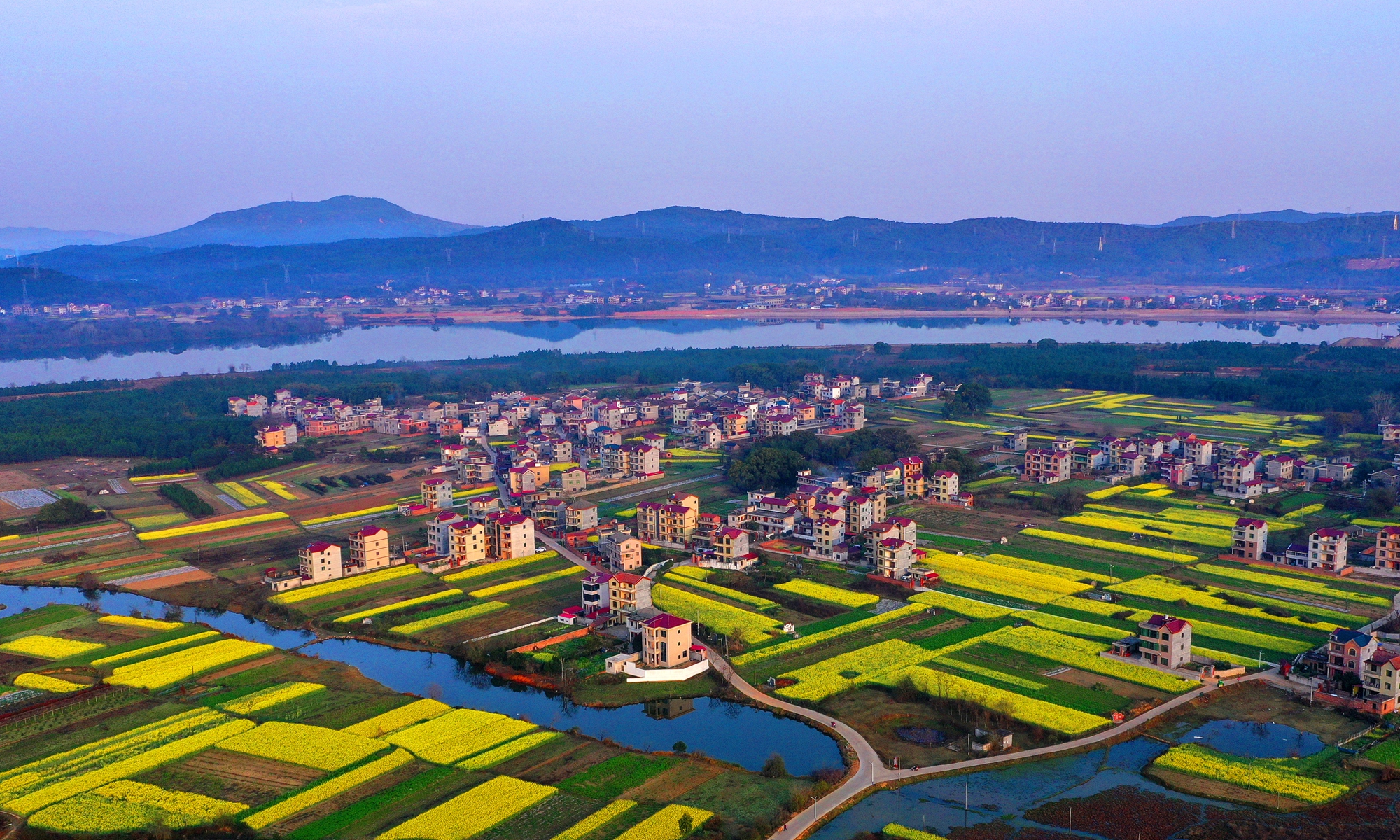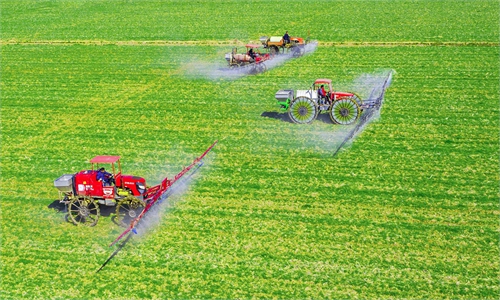China to accelerate reform to agriculture, ensuring food security
No.1 document to diversify rural industries, solve bottleneck seeds security

A general view of a rape flower field in a village in East China's Jiangxi Province on Sunday Photos: VCG
China's central government's "No. 1 document" for 2021 will boost the development of rural industries, including the development of a more self-reliant domestic seed industry, and integration with manufacturing and services sector aimed at diversifying the income of farmers, according to experts.
According to Li Guoxiang, a research fellow focusing on agriculture at the Chinese Academy of Social Sciences who focuses on seeds security, the No.1 document in 2021 will revitalize China's rural areas by diversifying industry in rural areas.
"The problem with China's rural areas is that apart from manual farming, some rural areas have no other industries," Li told the Global Times, "By promoting policy reform in rural areas, it needs to industrialize the agricultural sector, and introduce more manufacturing and services by encouraging farmers to extend their agricultural production capacity."
According to Li, the diversification of rural industries has made significant achievement in eastern China around the Yangtze River Delta, where the local agricultural sector has extended into more sophisticated processing of the crops and fruits, increasing local farmers' income and has been attracting more talent back home.
But Li also noted that the strategy should apply to different parts of the country, such as in the northern and western parts of China, where some people are still struggling with relatively low living standards.
"In less developed parts of the country, the No.1 document will aim to address urban-rural disparities and modernize the rural economy by improving infrastructure, supporting innovations in science and technology, advancing supply-side structural reform in agriculture, and deepening basic rural reforms including rural land ownership and subsidy system reforms," Li said.
The direction pinpointed in the document also draws on new issues, for example, the coronavirus-effected 2020, and potential challenges over the next few years, according to Jiao Shanwei, editor-in-chief of cngrain.com, a website specializing in grain news.
"Compared to past years' polices, this year's No.1 document stressed the importance of using advanced technology and human capital to facilitate the development of agriculture," Jiao said, "Over the past year, the problem of rising food prices that has effected the world seems to be intensifying. The COVID-19 pandemic has affected the food supply chain, highlighting the demand for the world's second-largest economy to strengthen self-reliance in grain supply. "

A general view of a rape flower field in a village in East China's Jiangxi Province on Sunday Photos: VCG
A Focus on grain security
Among the issues highlighted in rural policy this year, cultivation of grain and poultry was especially important, as the country seeks to upgrade technology across the agricultural sector to achieve a higher degree of self-reliance.
According to the No.1 document released by China's Ministry of Agriculture and Rural Affairs on Monday, China will strengthen its establishment of resources center for crops, poultry, livestock and marine fishery, and will give long-term support to key breeding program.
"China is capable of producing a large variety of grain seeds. China's self-selected crop breeding acreage accounts for more than 95 percent of farming, and increasingly the seeds are domestically engineered," Zhang Taolin, vice minister of the Ministry of Agriculture and Rural Affairs, said Monday.
The self-sufficiency ratio of key livestock, poultry, and aquatic products have already reached 75 and 85 percent, respectively, according to Zhang.
Industry experts say that the importance of crop and poultry cultivation has been underscored over recent years, but the level of attention shifted to seeds and breeding in this year's No.1 document is beyond expectation.
"It is unprecedented that the No.1 document places its main focus on breeding and seed security. There is a suite of policies aimed at supporting livestock breeders and seed producers,"Jiao said.
According to Jiao, the policy also shows that in terms of crop seeds, China still lags significantly behind the US, which currently takes up to more than 35 percent of the global seeds market. China's crops seeds market size was growing at a slow rate of around 3 percent before 2016, compared to the global average growth of 8.88 percent from 2005 to 2018.
In some of the crop seed technologies, China has made significant headways. According to Li Xinhai, head of Biotechnology Research Institute with the Chinese Academy of Agricultural Sciences, in recent years, China is self-sufficiency in seed cultivation in wheat and rice. Corn seeds developed by China also account for 91 percent in domestic market. However, there are still many challenges in terms of technological innovation.
"We fall behind developed countries mainly in the basic research into breeding traits. We lack in technological innovation when it comes to precise and efficient breeding," Li said, adding that "there are not enough varieties to meet the demand of high quality agricultural development."
According to Li, core technologies for future advances in seed breeding, including the core technical tools of gene editing, are still controlled by the US, and China should strengthen its efforts in basic research and cultivation technologies.
"We must put maximum effort into seed cultivation," Li noted, "the more advanced a country is, the more attention it gives to seeds security."

